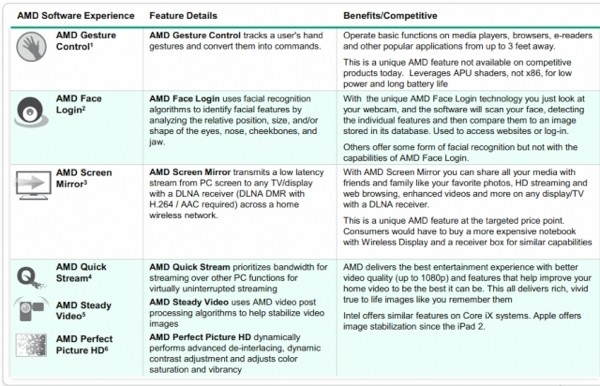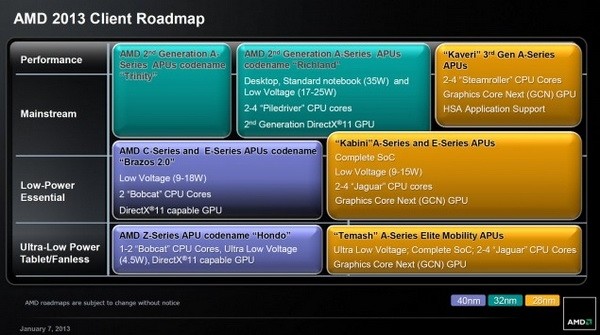AMD has formally announced its next generation of A-series processors, codenamed Richland, ahead of their planned availability in laptops starting next month. As we've mentioned before, this new APU uses the same base silicon as Trinity, including a Piledriver-based CPU and a GPU rooted in the Cayman architecture launched in 2011 as the HD 6970. It's even made on the same 32-nm process as Trinity, but AMD promises some clock speed improvements, better power management, and a few new software features.
The line-up
Four chips are being introduced today and they're all 35W parts intended for non-ultrabook class notebooks. These include a couple of quad cores, the A10-5750M and A8-5550M, as well as two dual cores branded as the A6-5350M and A4-5150M. Overall they offer around a 10% CPU frequency boost compared to the Trinity chips they are replacing as well as 4-7% faster graphics performance in base and Turbo Mode.
| Model | Cores | CPU Clock | GPU | GPU Clock | GPU Cores | L2 Cache | Max DDR3 | TDP |
|---|---|---|---|---|---|---|---|---|
| A10-5750M | 4 | 2.5 / 3.5GHz | HD 8650G | 533 / 720MHz | 384 | 4MB | DDR3-1866 | 35W |
| A8-5550M | 4 | 2.1 / 3.1GHz | HD 8550G | 515 / 720MHz | 256 | 4MB | DDR3-1600 | 35W |
| A6-5350M | 2 | 2.9 / 3.5GHz | HD 8450G | 533 / 720MHz | 192 | 1MB | DDR3-1600 | 35W |
| A4-5150M | 2 | 2.7 / 3.3GHz | HD 8350G | 514 / 720MHz | 128 | 1MB | DDR3-1600 | 35W |
Power management
Despite keeping the same power ratings as its predecessors AMD isn't just claiming a slight performance boost with Richland, it also says that the new platform should draw less overall power too under certain scenarios. AMD claims Richland consumes 17% less power than Trinity at idle and close to 40% less when playing 720p video, for example, but the new chips will draw just about the same power when browsing the web.

Much of this improvement is credited to a new Hybrid Boost power management scheme that uses on-die temperature sensors to determine what needs to be clocked down and what can keep running at higher frequencies, thus handling power consumption and clock speeds more effectively. This is similar to what Intel started doing with Sandy Bridge and Nvidia with GPU Boost 2.0 on the new GTX Titan.
In addition to temperature sensitivity, AMD also improved Richland's power management with smarter algorithms to determine if the CPU or GPU is bottlenecking system performance, and either save power or raise the voltage and clock speed for the corresponding component accordingly.
Software enhancements
AMD has introduced several platform-level enhancements, including support for the quick resume and wireless connect tech built into Windows 8, as well as a bundle of AMD-branded software that will supposedly enable new "experiences" for a more natural and differentiated user/PC interaction.
These include the gesture and facial-recognition features that AMD showed off at CES earlier this year to translate hand waving into commands for things like media playback or web browsing, and using your laptop's webcam to log into Windows – not ground-breaking or terribly useful features, but "Richland exclusives".
Perhaps more exciting is the introduction of Screen Mirror, which will let you stream video across a wireless network to any DLNA-compliant device. This is essentially AMD's answer to Intel's WiDi technology.

Other extras as part of the software bundle include AMD Quick Stream (prioritizes media streaming over other PC functions so no hiccups will occur), AMD Steady Video (uses processing algorithms to stabilize video images), and AMD Perfect Picture HD (de-interlacing, contrast enhancement, color saturation, and vibrancy).
Availability and the road ahead
As mentioned above, Richland APUs should arrive in regular laptops starting next month, while 17W variants for ultra-thin notebooks as well as desktop parts should get here by the Summer.
The new chips are somewhat of a stopgap solution for AMD, however, as the company is reportedly on track to replace Richland later this year with Kaveri. The latter is built on a 28nm process and will feature updated Steamroller CPU cores alongside a new integrated GPU based on the Graphics Core Next architecture.
